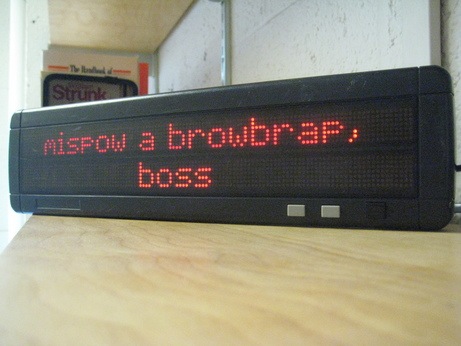
Here’s the latest iteration of Nick Montfort‘s ppg256 series, an ever-growing set of succinct poetry generators written in Perl. This one happens to be programmed to output to an LED sign, which is currently installed at Axiom (a Boston-area gallery for new and experimental media).
I would love to see how the piece looks and works in the context of a gallery. But more than anything I’d like to see some video: how the code manages the style and movement of the text can’t be anything but vital to the understanding of the piece.
Check out the thread at netpoetic for more photos and some interesting discussion.
In the most recent entries to the ppg256 series, Nick has started to explore the generation not just of abstract poetic form, but other speech genres as well: ppg256-3 generated tiny narratives (“the__bothat and one__orcman cut_out”), while ppg256-4 generates absurd imperatives (“delap the dappap, boss”). Like the other entries in the ppg256 series, ppg256-4 one is concerned with constructing plausible English words from minimalist parts; unlike the others, ppg256-4 is okay with (and even seems to revel in) neologism.
I’ve embedded some of the output of the (non-LED version) of ppg256-4 after the jump, in order to give a bit better sense of the program’s flavor. Read the rest of this entry »
